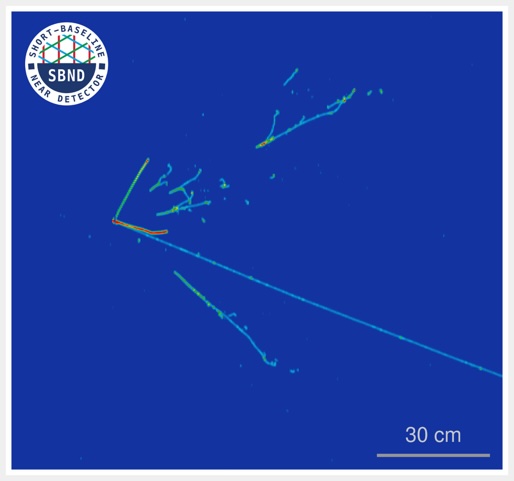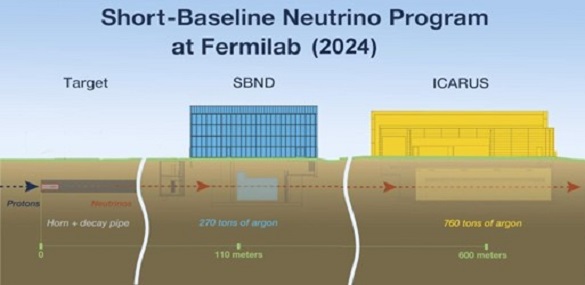First neutrinos detected at Fermilab short-baseline detector
Published on

After years of preparation, the first neutrinos have been observed by scientists working on the Short-Baseline Near Detector (SBND) at Fermi National Accelerator Laboratory in the USA.
The SBND is an the international collaboration involving 250 physicists and engineers from the UK, Brazil, Spain, Switzerland and the United States.
The University of Liverpool is a founding member of the SBND collaboration, with several physicists playing pivotal roles in the construction, commissioning and preparation for the physics exploitation of the detector. In addition, Liverpool PhD students have made significant contributions to both the detector and its physics goals.
The SBND team has been planning, prototyping and constructing the detector for nearly a decade. And, after a few-months-long process of carefully turning on each of the detector subsystems, the moment they’d all been waiting for finally arrived.
“It isn’t every day that a detector sees its first neutrinos,” said David Schmitz, co-spokesperson for the SBND collaboration. “We’ve all spent years working toward this moment and this first data is a very promising start to our search for new physics.”
[caption id="attachment_122094" align="alignnone" width="514"] Display of a candidate muon neutrino interaction observed by the Short-Baseline Near Detector. Credit: SBND collaboration[/caption]
Display of a candidate muon neutrino interaction observed by the Short-Baseline Near Detector. Credit: SBND collaboration[/caption]
The Standard Model is the best theory for how the universe works at its most fundamental level. It is the gold standard particle physicists use to calculate everything from high-intensity particle collisions in particle accelerators to very rare decays. But despite being a well-tested theory, the Standard Model is incomplete. And over the past 30 years, multiple experiments have observed anomalies that may hint at the existence of a new type of neutrino.
Neutrinos are the second most abundant particle in the universe. Despite being so abundant, they’re incredibly difficult to study because they only interact through gravity and the weak nuclear force, meaning they hardly ever show up in a detector.
Neutrinos come in three types, or flavors: muon, electron and tau. Perhaps the strangest thing about these particles is that they change among these flavors, oscillating from muon to electron to tau.
Scientists have a pretty good idea of how many of each type of neutrino should be present at different distances from a neutrino source. Yet observations from a few previous neutrino experiments disagreed with those predictions.
The Short Baseline Neutrino Program at Fermilab will perform searches for neutrino oscillation and look for evidence that could point to this fourth neutrino. SBND is the near detector for the Short Baseline Neutrino Program while ICARUS, which started collecting data in 2021, is the far detector. A third detector called MicroBooNE finished recording particle collisions with the same neutrino beamline that same year.

The Short Baseline Neutrino Program at Fermilab differs from previous short-baseline measurements with accelerator-made neutrinos because it features both a near detector and far detector. SBND will measure the neutrinos as they were produced in the Fermilab beam and ICARUS will measure the neutrinos after they’ve potentially oscillated. So, where previous experiments had to make assumptions about the original composition of the neutrino beam, the SBN Program will definitively know.
“Understanding the anomalies seen by previous experiments has been a major goal in the field for the last 25 years,” said Schmitz. “Together SBND and ICARUS will have outstanding ability to test the existence of these new neutrinos.”
Professor Costas Andreopoulos, leader of the SBND team at Liverpool, said: “SBND's superb imaging capabilities have been showcased in the remarkable first neutrino events we've captured, This achievement is the culmination of over a decade of dedicated work. The data collected from SBND will enable us to pursue an extensive physics program and refine our tools and analysis methodologies as we prepare for the groundbreaking DUNE experiment, set to begin early in the next decade.”
Christos Touramanis, Professor of Experimental Particle Physics at the University, said: “This is a big day for the Liverpool neutrino group. In the last 15 years we have been leading internationally the development of the technology used in SBND, the Liquid Argon Time Projection Chamber, and we have delivered key components and provided leadership in the making of the detector and shaping the science programme. We are ready and eager to use SBND data to elucidate the mysteries of neutrinos and possibly to determine the nature of dark matter."
Beyond the hunt for new neutrinos
In addition to searching for a fourth neutrino alongside ICARUS, SBND has an exciting physics program on its own.
Because it is located so close to the neutrino beam, SBND will see 7,000 interactions per day, more neutrinos than any other detector of its kind. The large data sample will allow researchers to study neutrino interactions with unprecedented precision. The physics of these interactions is an important element of future experiments that will use liquid argon to detect neutrinos, such as the long-baseline Deep Underground Neutrino Experiment, known as DUNE.
Whenever a neutrino collides with the nucleus of an atom, the interaction sends a spray of particles careening through the detector. Physicists need to account for all the particles produced during that interaction, both those visible and invisible, to infer the properties of the ghostly neutrinos.
It’s relatively easy to model what happens with simple nuclei, like helium and hydrogen, but SBND, like many modern neutrino experiments, uses argon to trap neutrinos. The nucleus of an argon atom consists of 40 nucleons, making interactions with argon more complex and more difficult to understand.
But neutrinos won’t be the only particles SBND scientists will keep an eye out for. With the detector located so close to the particle beam, it’s possible that the collaboration could see other surprises.
One of the biggest questions the Standard Model doesn’t have an answer for is dark matter. Although SBND would only be sensitive to lightweight particles, those theoretical particles could provide a first glimpse at a ‘dark sector’.
Dr Kostas Mavrokoridis, Reader in Experimental Particle Physics, added: “It was great honour to have worked with experts from around the world to deliver integral components for the heart of the 110-ton SBND Liquid Argon detector now at Fermilab. We live for these moments of awe, and certainly seeing the first Neutrino interaction in the SBND detector is a great reward after so much work. I am looking forward to the exploitation and the amazing physics to come.”
The Short-Baseline Near Detector international collaboration is hosted by the U.S. Department of Energy’s Fermi National Accelerator Laboratory. The collaboration consists of 38 partner institutions, including national labs and universities from five countries. SBND is one of two particle detectors in the Short-Baseline Neutrino Program that provides information on a beam of neutrinos created by Fermilab's particle accelerators.